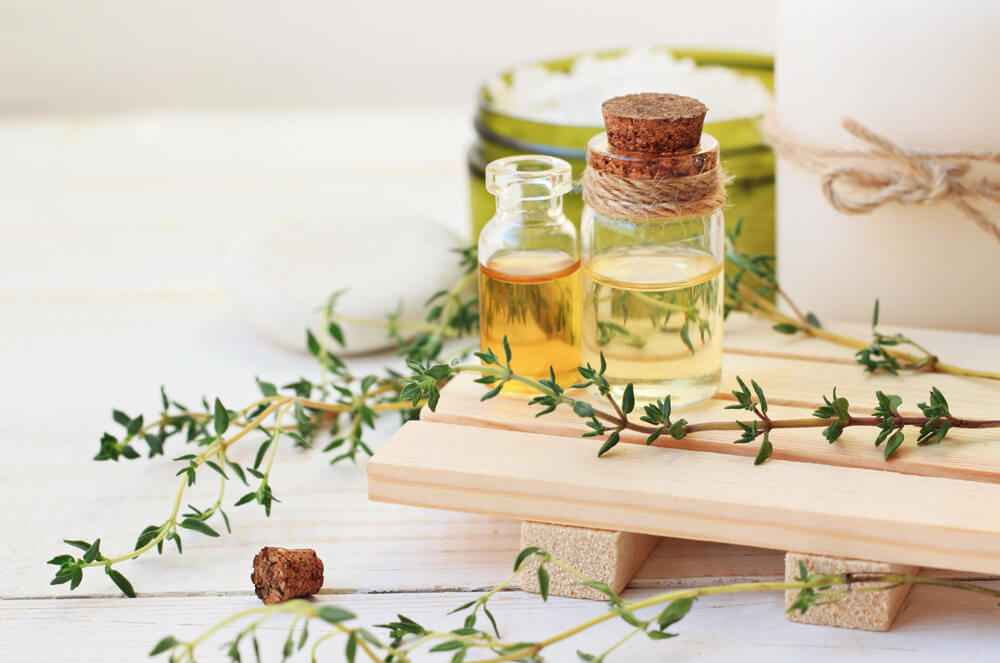When you hear the words essential oils, does it make you want to head to the spa? It’s true, massage therapists use oils to help people relax and unwind. But, did you know essential oils are also effective for children with autism and attention deficit hyperactivity disorder (ADHD)? Before we discuss the best essential oils for ADHD and autism, let’s talk about what they are and what they can do for the body.

What is an Essential Oil?
An ‘essential oil’ is a liquid distilled from the leaves, stems, flowers, bark, roots, and other parts of a plant. The term is a contraction of the original ‘quintessential oil’ which originated from the Aristotelian idea that matter is composed of four elements: fire, air, earth, and water. The fifth element, quintessence, is the spirit or life force of matter.
The chemical composition and aroma of essential oils can provide many psychological and physical therapeutic benefits. These benefits can be gained by either inhaling the scent or by applying diluted versions to the skin.
Essential oils are obtained from plants through distillation, usually by using steam. Manufacturers also use an expression, solvent extraction, absolute oil extraction, resin tapping, and cold pressing. Despite the use of the word ‘oil,’ most essential oils don’t have that oily feeling. These oils are usually clear, but patchouli, orange, and lemongrass can be amber or yellow.
Some people may believe essential oils are the same as perfume or fragrance oils, but they are not. Essential oils are derived from true plants and contain the true essence of the plant they came from. Fragrance oils are different because they contain artificial ingredients and substances. Also, they do not have the therapeutic benefits that essential oils can provide.
General Benefits of Essential Oils for Kids
Throughout history, essential oils have been used for medicinal purposes by people all over the world. Some known benefits of these oils are their ability to:
- Support healthy body functions and help boost the immune system.
- Relieve discomfort and sore muscles after exercising.
- Soothe the digestive system. Peppermint, for example, is known to support the healthy function of your stomach and digestive organs.
- Enhance a massage.
- Boost your ability to focus and concentrate.
- Help you relax and reduce your stress levels. This is perhaps one of the reasons essential oils for ADHD and autism are gaining in popularity these days. Essential oils can penetrate the skin and cross the brain-blood barrier to reach the amygdala and other limbic parts of the brain that control our mood and emotions.
- Promote wellness.
- Provide safer and non-toxic ways to clean and purify both home and workspaces.
- Help you achieve healthier skin and great-looking hair.
Using Essential Oils on Children with Autism, ADHD, and ADD
Transition periods can be challenging for many children with an autism spectrum disorder. For example, it can be hard when a child has to transition to bedtime. Studies show more than half of kids with autism have issues falling asleep or staying asleep.
Can essential oils help calm kids with ASD and ADHD?
You can find many online blogs and articles brimming with testimonials on the use of essential and calming oils for ASD and ADHD. But is there scientific proof they work?
Researchers at the Ohio State University Wexner Medical Center aim to answer this question. Dr. Jill Hollway, Ph.D., MA, is conducting a two-year study to investigate whether essential oils can help people with autism. Certain oils are soothing on their own, but Dr. Hollway is taking it a step further. She hopes to determine whether a combination of essential oils can improve relaxation and sleep.
If you want to try essential oils on your child with an autism spectrum disorder, you must educate yourself to prevent harm.
As previously mentioned, some essential oils can be applied directly on the skin. In the case of children with autism, the oils should be applied to the soles of the feet, the neck, the top of the head, the chest, the forehead, the abdomen, the arms, and the legs. According to parents who have found success with essential oils, it works right away, as oils can enter the bloodstream within 30 seconds. Within 30 minutes, they can be circulated through the entire body. It’s important to note some oils need to be diluted with carrier oils for safety, which will be explained later in this article.
To ensure efficiency, it is recommended that essential oils are used two to three times a day at the start. Then, the frequency should be gradually reduced to once a day.
In addition to applying essential oils to the skin, parents can use an aromatic diffuser to reap benefits. This is an air vaporizer that allows you to disperse your essential oil of choice by adding it to distilled water.
Not only does the essential oil help children relax or sleep, but the diffuser also helps purify rooms and remove bacteria and viruses from the air. It can help you create a better living environment for the entire family. You can also use it at the office to help you stay focused and reduce stress levels.
A word of caution, though. Always make sure to store essential oils in glass containers. According to experts, they can be contaminated with toxins and other harmful substances if you leave them in a plastic container or diffuser.
List of Recommended Essential Oils for Autism and ADHD
1. Frankincense Oil
Also known as olibanum, frankincense oil is taken from the resin of the Boswellia carterri or Boswellia sacara tree that grows in Somalia. It has anti-bacterial, anti-tumor, and anti-viral properties that can aid in recovery from respiratory infections, indigestion, arthritis, and joint pain. Research has shown that it can also help boost the immune system.
For children with autism or ADHD, frankincense oil benefits include helping them stay focused. It is also known to help reduce stress reactions and negative emotions.
2. Vetiver Oil
Vetiver oil is obtained through the steam distillation of the roots of the vetiver plant (Chrysopogon zizanioides), a perennial grass native to India. It has antiseptic and antispasmodic properties that aid in the healing of wounds and scars and provides inflammation relief.
In 2001, a study conducted by Dr. Terry Friedman revealed that vetiver essential oil benefits children with ADHD. The oil’s relaxing and calming properties are said to help children combat symptoms of ADHD and ADD symptoms such as difficulty in concentrating, being distracted, and impatience.
3. Sandalwood Oil
Known for its woodsy and sweet smell, sandalwood oil is derived from the mature roots of the sandalwood tree through steam distillation. The more mature the tree is, the more potent the extracted essential oil would be.
One of the major sandalwood oil benefits is that it helps mental clarity, especially when used with a diffuser. It also has a relaxing and calming effect that can be effective for children with autism spectrum disorders. Apart from that, sandalwood can have anti-inflammatory, anti-aging, and anti-viral properties.
4. Cedarwood Oil
Like sandalwood and vetiver essential oils, cedar oil is extracted by steam-distilling pieces of the cedar wood tree. Major components of this essential oil include alpha-cedrene, beta-cedrene, cedrol, widdrol, and thujopsene. It can be used for treating eczema, hair loss, dry scalp, and the inflammation of the joints and tissues.
Cedarwood essential oil can also help children with autism and ADHD. It has calming and relaxing properties. Its scent promotes the release of serotonin, which is then converted into melatonin in the brain. This can help children enjoy peaceful and restorative sleep.
5. Lavender Oil
Throughout the centuries, lavender oil has been used by different civilizations for its medicinal properties. For instance, the Egyptians used it for mummification, while the Romans used it for bathing and cooking. Perhaps the most famous usage of all is when Mary Magdalene used it to anoint Jesus.
There are many lavender oil benefits. For starters, it has antioxidants that protect your body from illnesses. It also helps heal burns and wounds, alleviates headaches, and may be useful in the treatment of diabetes. It has a calming effect on children on the autism spectrum and can help improve sleep quality and reduce anxiety and emotional stress.
6. Mandarin Oil
Mandarin essential oil has been used in traditional Chinese medicine for thousands of years. Known to be the sweetest and most calming of all citrus essential oils, it is very mild and contains many healing properties.
Mandarin oil can treat acne, reduce insomnia, and manage gut issues like leaky gut syndrome. And thanks to its anti-microbial and anti-tumor properties, it may even help with the treatment of certain types of cancer. It is particularly useful for children because many kids are fond of its citrusy scent. It can also help reduce anxiety levels.
7. Peppermint Oil
Peppermint is perhaps one of the most versatile of all essential oils in the world. It is perfect for children with autism and ADHD because it gives a cooling sensation and has a calming effect on the body. It is also known to help improve mental focus.
Peppermint essential oil also has anti-microbial properties that help freshen bad breath and heal digestive issues. It can also help relieve headaches, clear the respiratory tract, and soothe tight and tired muscles.
8. Ylang Ylang Oil
Ylang ylang essential oil is from the flower petals of the large ylang-ylang tree (Cananga odorata), which is often found in tropical countries. This essential oil is quite popular for its sweet, floral scent. In fact, it is one of the key ingredients of Chanel No. 5.
Ylang-ylang oil has effective sedative, antiseptic, anti-spasmodic, and anti-depressant properties. It has a positive effect on human emotions and can help increase the blood flow to certain parts of the body. It can relieve inflammation and help the function of cardiovascular and digestive systems.
9. Bergamot Oil
Bergamot essential oil is from the peel of the fruit of the bergamot plant through cold compression. It is often used to reduce pain caused by headaches and muscle tension. It has anti-bacterial properties that can help heal wounds and minimize marks on the skin.
Known as an excellent mood enhancer, bergamot can be a great essential oil for autism. It helps create a feeling of joy, freshness, and energy by improving the circulation of blood. Bergamot oil also works as a relaxant as it has a calming effect and can reduce feelings of stress and anxiety.
10. Chamomile Oil
For nearly 5,000 years, chamomile has been used to treat various ailments. Whether in tea or in oil form, this versatile medicinal herb is rich in disease-fighting antioxidants such as terpenoids and flavonoids.
Chamomile essential oil is one of the best when it comes to fighting stress and anxiety. According to a study published in Alternative Therapies in Health and Medicine and Pharmacognosy Review, inhaling chamomile promotes relaxation. Chamomile oil also has strong anti-inflammatory and pain-reducing abilities and can help relieve congestion, strengthen the heart, improve digestion, and even fight cancer.
A Few Important Reminders on Using Essential Oils
Essential oils are potent. When you use essential oils for autism spectrum disorders, it’s essential you be very careful. Also, you should use as little as needed. Always remember that more is not always the best. When a few drops of essential oil will do, you should neither use more nor consume it internally. Otherwise, it may put your health at risk.
If this is your first time using essential oils for your child with ASD, it would be wise to check with a qualified professional to determine whether you want to use it topically or aromatically.
When using essential oils topically, dilute them with a safe carrier oil. Carrier oils can be fractionated coconut oil or grapeseed oil. It helps prevent the skin from getting burned when it comes into contact with certain types of essential oil. For adults, one drop of essential oil with every three drops of carrier oil is the recommended ratio. For children, it should be three times more, depending on the size and weight of the child. If you don’t have carrier oil, high-quality olive oil can be a good alternative.
Essential oils that are known for being ‘hot’ and therefore need dilution are birch, cassia, cinnamon, clove, eucalyptus, ginger, lemongrass, oregano, peppermint, thyme, and wintergreen. Before using any of these essential oils, it’s recommended that you test them first by applying them on the wrist or the bottom of the feet. Also, make sure that you keep them away from your eyes.
It is also advisable that you consult a qualified aromatherapist or a doctor before applying any type of essential oil on the skin, especially on children. Apart from applying essential oils on your skin, you can also inhale it by using a diffuser. Some research has shown that aromatic use can be more effective and safer.
When they are not in use, essential oils should be kept in a bottle with a closed lid and away from extreme temperatures so they last longer.
What to Consider When Buying Essential Oils For Your Child With Autism
Quality is a key consideration to make when determining which essential oils are best for autism. If the oils are of low quality, you may not be able to get optimum results. Manufacturers may stamp the word “pure” on their labels, but it doesn’t ensure quality. And since essential oils are not regulated, some manufacturers may say they are ‘organic’ when they are not.
Some manufacturers use chemicals when extracting the essential oil from plants, thus making the oils neither pure nor organic. That’s why it’s important that you take a closer look at how it is extracted. This will help you determine if the manufacturers’ claims are true. Also, you should avoid anything that says ‘fragrance’ or ‘perfume.’
Essential oils that are considered 100 percent pure and therapeutic-grade are those extracted from plants, flowers, trees, roots, and seeds among those using low, slow steam distillation (for non-citrus essential oils) or cold-pressed (for citrus oils). Depending on the product and company, pure essential oil extracts can be 50 to 200 times more concentrated than their source.
Single oils can be blended to create another type of essential oil or to enhance their effects. But, they should be blended to ensure that they are effective, safer, and easier to use.
Purity is one of the most important characteristics of essential oils. Poor production processes and the development of synthetic essential oil variations can affect quality. If you want to get the best results, opt for Certified Pure Therapeutic Grade (CPTG) essential oils. These oils, like doTerra oils for autism, undergo rigorous testing to ensure purity and quality.
CPTG quality testing is done to ensure that essential oils are made using proper methods of growing, harvesting, and distilling their plant source. It’s done through a series of processes that include:
- Validation of Quality
Each essential oil is reviewed for chemical composition after plant selection, harvesting, and distillation. It is then tested two more times to confirm it remained free of contaminants and unexpected alterations during production. - Organoleptic Testing
This testing involves the use of the human senses to determine the quality and acceptability of the product. - Microbial Testing
Under microbial testing, a batch of essential oils is analyzed and tested for the presence of micro-organisms like fungi, bacteria, viruses, and mold that can be detrimental to your health. Samples are taken before and after the essential oils are packed to ensure they haven’t been contaminated during the packaging process. - Gas Chromatography and Mass Spectrometry Analysis (GC/MS)
In this process, essential oils are vaporized and passed through a long column to separate them into individual components. This is to determine the exact chemical composition of a particular essential oil. - Fourier Transform Infrared Spectroscopy (FTIR)
FTIR is designed to ensure that each batch of essential oil is potent and consistent. As part of this test, structural components of essential oil compounds are analyzed by passing them through infrared light. - Heavy-Metal TestingHeavy-metal testing determines the heavy metal content in the essential oil. Ideally, pure essential oils do not contain heavy metals when distilled.
Certified Pure Therapeutic Grade Essential Oils
Purity is one of the most important characteristics of essential oils. Among the things that can affect purity are poor production processes and the development of synthetic essential oil variations. If you want to get the best results possible, you’d want to opt for Certified Pure Therapeutic Grade (CPTG) essential oils. These oils, like doTerra essential oils for autism, undergo rigorous testing to ensure purity and quality.
CPTG quality testing is done to ensure that essential oils are made by using proper methods of growing, harvesting, and distilling their plant source. It is done through a series of processes that include:
- Validation of QualityUnder this process, each essential oil is reviewed for chemical composition after plant selection, harvesting, and distillation. Then, it is tested two more times to confirm that it has remained free of contaminants and unexpected alterations during production.
- Organoleptic TestingOrganoleptic testing involves the use of the human senses to determine the quality and acceptability of the product.
- Microbial TestingUnder microbial testing, a batch of essential oils is analyzed and tested for the presence of micro-organisms like fungi, bacteria, viruses, and mold that can be detrimental to your health. Samples are taken before and after the essential oils are packed to ensure they haven’t been contaminated during the packaging process.
- Gas Chromatography and Mass Spectrometry Analysis (GC/MS)In this process, essential oils are vaporized and passed through a long column to separate them into individual components. This is to determine the exact chemical composition of a particular essential oil.
- Fourier Transform Infrared SpectroscopyFourier Transform Infrared Spectroscopy (FTIR) is designed to ensure that each batch of essential oil is potent and consistent. As part of this test, structural components of essential oil compounds are analyzed by passing them through infrared light.
- Heavy-Metal TestingHeavy metal testing determines the heavy metal content in the essential oil. Ideally, pure essential oils do not contain heavy metals when distilled.
Health Benefits of Essential Oils
The health benefits of essential oils many. But as with anything that can affect your health and well-being, educate yourself. Research and seek expert advice to avoid allergies and other harmful side effects.
It’s also very important to ensure the quality of the essentials oils you want to use. Essential oils that contain chemicals or artificial ingredients may not be as potent and effective as pure and organic essential oils. They may even cause problems so be vigilant and stay informed.
https://www.autismparentingmagazine.com/essential-oils-for-autism-adhd-add/
Not all oils are considered safe for people with epilepsy or other coexisting conditions, ALWAYS confirm safety with your doctor before using any oils.
Autism Parenting Magazine tries to deliver honest, unbiased reviews, resources, and advice, but please note that due to the variety of capabilities of people on the spectrum, information cannot be guaranteed by the magazine or its writers. Medical content, including but not limited to, text, graphics, images and other material contained within is never intended to be a substitute for professional medical advice, diagnosis, or treatment. Always seek the advice of a physician with any questions you may have regarding a medical condition and never disregard professional medical advice or delay in seeking it because of something you have read within.





Leave A Comment